Tuesday, March 04 2014
In our previous Blog below, we showed a breakout of the SPY above its all-time high level of $185 on 2/27/2013 (Thursday) and a confirmation of this breakout on Friday. After a single day of dealing with Putin's ego on Monday (SPY back down to close a fraction below $185), the SPY bounced back up today to $187.85 (new high). And, it was very comforting to see higher volume on the up days (see graph immediately below).
All of this is good news for the bulls. The market should push even higher in the short-term (weeks/months). For this to actually happen, however, we need to see continuing higher levels for the SPY from here or at least several solid days above $185. Most likely, the SPY will come back down to test this new $185 support level and the SPY must "hold the line" there for this "breakout" to be real and lasting.
Still, its anybody's guess. To our benefit, we have MIPS to tell us what to do (all MIPS models are still long).
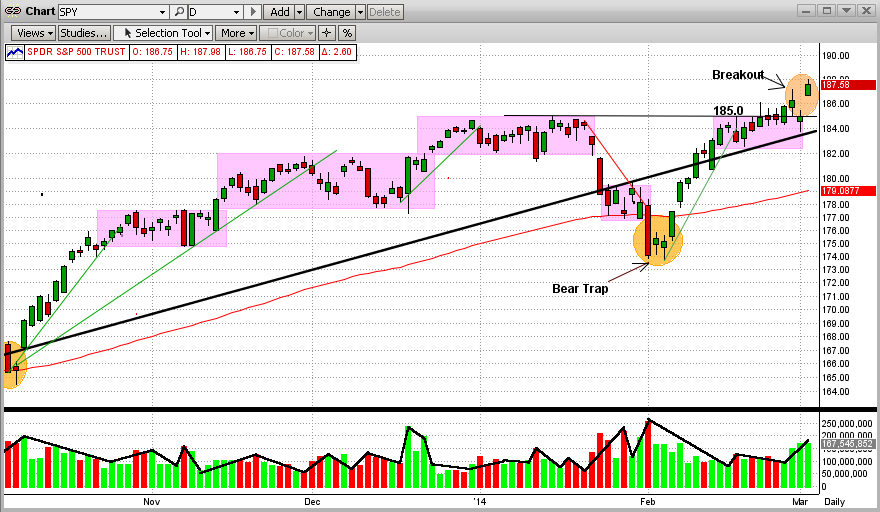
<<< Previous Blog >>>
MIPS Members:
After the SPY hit or broke its all-time high resistance level at $185 for the last 5 of 6 days and got slapped back each time, it finally broke out above that level on 2/27/2013 (see graph immediately below). Although the breakout was not dramatic (no gaps, no extremely high volume, etc), it was a classic breakout. The SPY opened lower than the previous day's close, and steadily climbed all the way to $185.82 on the close on Thursday.
From this, one would expect the market to climb from here. So far on Friday (10:15 am CST), all of the major indices are up (with the SPY up +0.5%). For how long and how high this continues, we will have to wait and see. All of the MIPS models are still long at this time.
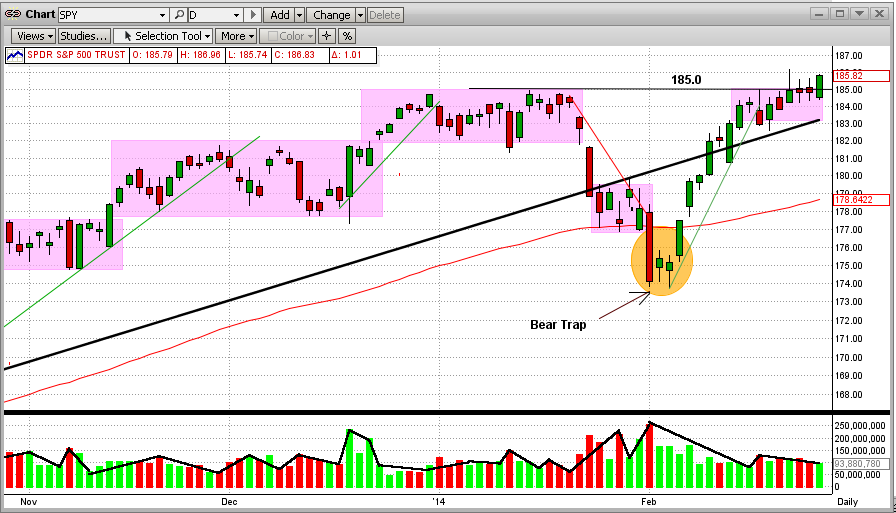
<<< Previous Blog >>>
MIPS Members:
In our previous blog below, we pointed out how the SPY had made a dramatic change in direction in the first week of Feb'14, and turned up in what seemed to be a powerful uptrend. But, the uptrend lacked strong momentum due to the low volume in this uptrend. In other words, the uptrend was the result of buying by the little guys and was NOT joined by the fat kats.
So, what has happened since then? The SPY uptrend hit what I call a chartist's "stone wall" at its previous all-time high of 185.0 (see chart immediately below). And, by the way, the SPY tried to break through 185.0 in 3 of the last 4 trading days, only to be slapped back at exactly 185 all 3 times. The little guys could not push the SPY through the 185.0 resistance level all by themselves. And, they will not try this alone much longer. My opinion is that, if this market gets some support from the fat kats, the SPY will continue up to new highs. But with the little guys alone, it cannot. The SPY volume levels will be high on my radar screen next week.
And, of course, if the little guys give up or the fat kats go against them, the SPY will most likely fall back to its support level at 174, or below.
It's so good to put the decision of what to do on the shoulders of the MIPS models so we can sleep at night. Let's wait for MIPS to tell us what to do, and when.
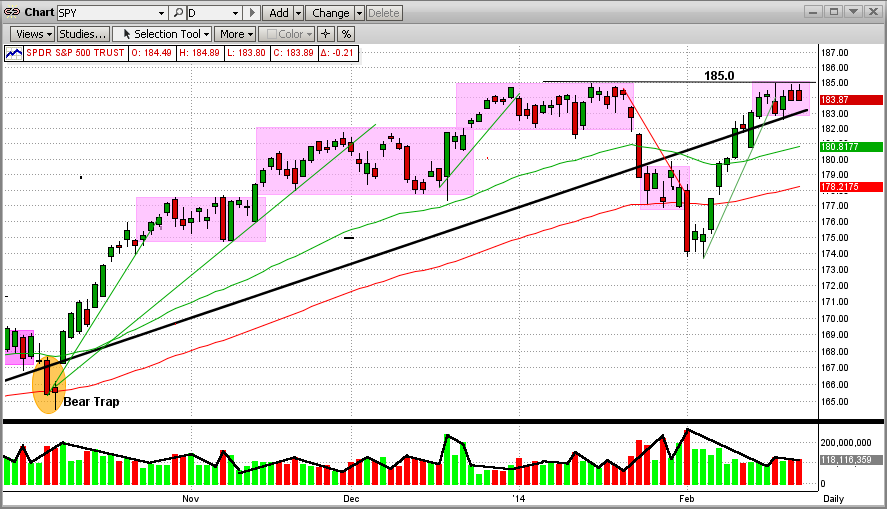
Friday, February 28 2014
MIPS Members:
After the SPY hit or broke its all-time high resistance level at $185 for the last 5 of 6 days and got slapped back each time, it finally broke out above that level on 2/27/2013 (see graph immediately below). Although the breakout was not dramatic (no gaps, no extremely high volume, etc), it was a classic breakout. The SPY opened lower than the previous day's close, and steadily climbed all the way to $185.82 on the close on Thursday.
From this, one would expect the market to climb from here. So far on Friday (10:15 am CST), all of the major indices are up (with the SPY up +0.5%). For how long and how high this continues, we will have to wait and see. All of the MIPS models are still long at this time.

<<< Previous Blog >>>
MIPS Members:
In our previous blog below, we pointed out how the SPY had made a dramatic change in direction in the first week of Feb'14, and turned up in what seemed to be a powerful uptrend. But, the uptrend lacked strong momentum due to the low volume in this uptrend. In other words, the uptrend was the result of buying by the little guys and was NOT joined by the fat kats.
So, what has happened since then? The SPY uptrend hit what I call a chartist's "stone wall" at its previous all-time high of 185.0 (see chart immediately below). And, by the way, the SPY tried to break through 185.0 in 3 of the last 4 trading days, only to be slapped back at exactly 185 all 3 times. The little guys could not push the SPY through the 185.0 resistance level all by themselves. And, they will not try this alone much longer. My opinion is that, if this market gets some support from the fat kats, the SPY will continue up to new highs. But with the little guys alone, it cannot. The SPY volume levels will be high on my radar screen next week.
And, of course, if the little guys give up or the fat kats go against them, the SPY will most likely fall back to its support level at 174, or below.
It's so good to put the decision of what to do on the shoulders of the MIPS models so we can sleep at night. Let's wait for MIPS to tell us what to do, and when.

<<< Previous blog >>>
MIPS Members:
The market has undergone a remarkable rebound so far in Feb'14 (see graph below). In the last 10 days, the SPY regained almost all of the ground that it lost in the 10 days before that. Problem is, however, that the rebound thus far has been on ever decreasing volume, so it was not caused by the big guys.
So, where does the SPY go from here. From global economic conditions, the actions of the Fed, and the market's technical indicators, one could make a good case for the SPY to go up (to over 200) or down (to below 160) from here. And, we at MIPS sure don't have a prediction either way at this time (but MIPS will in ample time).
If outside conditions don't greatly surprise us, we believe that the SPY will go up and try (at least several times) to break through its previous high of $185 to the upside. If it does, there is not a consensus top where it may play out. On the other hand, if the SPY fails to break its previous high (again, after several tries), it will most likely drop all the way back to $174. And, if it breaches its support at that level, then look for it to fall to 160 or lower. The worst case is that the SPY goes into a sideways trading pattern between 174-185, thus developing into a pattern that is ripe for whipsawing.
We will wait for the big guys to make up their minds and start their move, and then let MIPS tell us what to do, and when.

Sunday, February 23 2014
MIPS Members:
In our previous blog below, we pointed out how the SPY had made a dramatic change in direction in the first week of Feb'14, and turned up in what seemed to be a powerful uptrend. But, the uptrend lacked strong momentum due to the low volume in this uptrend. In other words, the uptrend was the result of buying by the little guys and was NOT joined by the fat kats.
So, what has happened since then? The SPY uptrend hit what I call a chartist's "stone wall" at its previous all-time high of 185.0 (see chart immediately below). And, by the way, the SPY tried to break through 185.0 in 3 of the last 4 trading days, only to be slapped back at exactly 185 all 3 times. The little guys could not push the SPY through the 185.0 resistance level all by themselves. And, they will not try this alone much longer. My opinion is that, if this market gets some support from the fat kats, the SPY will continue up to new highs. But with the little guys alone, it cannot. The SPY volume levels will be high on my radar screen next week.
And, of course, if the little guys give up or the fat kats go against them, the SPY will most likely fall back to its support level at 174, or below.
It's so good to put the decision of what to do on the shoulders of the MIPS models so we can sleep at night. Let's wait for MIPS to tell us what to do, and when.

<<< Previous blog >>>
MIPS Members:
The market has undergone a remarkable rebound so far in Feb'14 (see graph below). In the last 10 days, the SPY regained almost all of the ground that it lost in the 10 days before that. Problem is, however, that the rebound thus far has been on ever decreasing volume, so it was not caused by the big guys.
So, where does the SPY go from here. From global economic conditions, the actions of the Fed, and the market's technical indicators, one could make a good case for the SPY to go up (to over 200) or down (to below 160) from here. And, we at MIPS sure don't have a prediction either way at this time (but MIPS will in ample time).
If outside conditions don't greatly surprise us, we believe that the SPY will go up and try (at least several times) to break through its previous high of $185 to the upside. If it does, there is not a consensus top where it may play out. On the other hand, if the SPY fails to break its previous high (again, after several tries), it will most likely drop all the way back to $174. And, if it breaches its support at that level, then look for it to fall to 160 or lower. The worst case is that the SPY goes into a sideways trading pattern between 174-185, thus developing into a pattern that is ripe for whipsawing.
We will wait for the big guys to make up their minds and start their move, and then let MIPS tell us what to do, and when.

Saturday, February 15 2014
The market has undergone a remarkable rebound so far in Feb'14 (see graph below). In the last 10 days, the SPY regained almost all of the ground that it lost in the 10 days before that. Problem is, however, that the rebound thus far has been on ever decreasing volume, so it was not caused by the big guys.
So, where does the SPY go from here. From global economic conditions, the actions of the Fed, and the market's technical indicators, one could make a good case for the SPY to go up (to over 200) or down (to below 160) from here. And, we at MIPS sure don't have a prediction either way at this time (but MIPS will in ample time).
If outside conditions don't greatly surprise us, we believe that the SPY will go up and try (at least several times) to break through its previous high of $185 to the upside. If it does, there is not a consensus top where it may play out. On the other hand, if the SPY fails to break its previous high (again, after several tries) , it will most likely drop all the way back to $174. And, if it breaches its support at that level, then look for it to fall to 160 or lower. The worst case is that the SPY goes into a sideways trading pattern between 174-185, thus developing into a pattern that is ripe for whipsawing.
We will wait for the big guys to make up their minds and start their move, and then let MIPS tell us what to do, and when.

Friday, January 31 2014
Up day, down day; three up days, three down days; etc. We have seen three multi-week sideways trading patterns in the SPY since October 2013. Then, we had a relatively big drop six days ago, followed by what is looking like another sideways trading pattern. In effect, the market has not really gone anywhere since mid-November 2013. So, is this the start of the Big One Down?
Read on... This blog is an update to a prior blog entitled "Market Crash Coming?" (see below).
The points of our previous blog below are that: (1) the last two crashes in 2000 & 2008 took 8-9 months to develop, so the Big Ones do not normally happen quickly, and (2) when the big drop started in 2008, MIPS3 picked it up quickly and did very well for the year (MIPS3 up over 50%, SPY down over 50%).
As mentioned above, in the last few days, the SPY movements have developed into another sideways pattern, and of course, no one knows which way it will break out from here. But, the breakout is usually in the same direction that the market was heading when it went into the pattern. In this case, that means down, but the bulls are still flexing their muscles to the upside (with help from the Fed). So far this year, there has not been much harm done either way because every down day has been followed by an up day. This is not usually a recipe for a big drop, but anything can happen. Of course, MIPS is analyzing the market movements in many ways that we cannot. And, the MIPS models were developed to not "jump-the-gun" (like we might do), and make a big mistake.
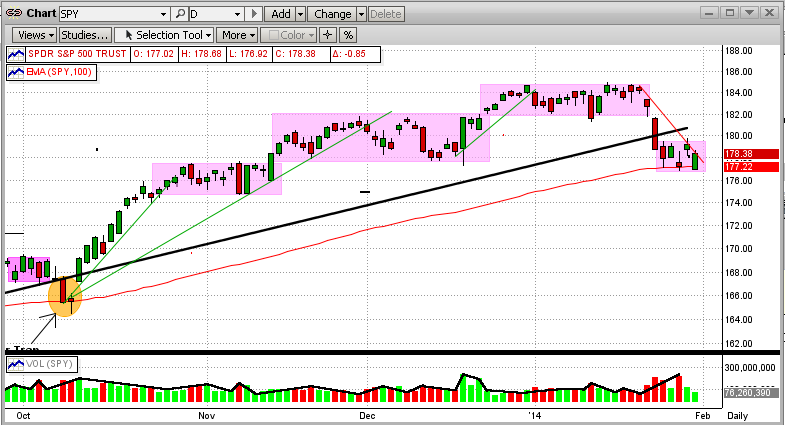
BTW, many investors are freaking out because of the market weakness in the last seven days. But,
the seemingly "big" market drop that we are seeing now is actually "tiny" once you stand back
and look at it from a long-term perspective (like over several years, as in the graph below).
Then, you can see that this year's "dip" is hardly even noticeable compared to other market "drops"
between 2007 and now.
- So, sit tight and don't panic.
- Remember, many investors lose most of their money thru panic selling, but a good "mechanical"
model should give you the confidence and discipline to "stay put" until you get another signal.
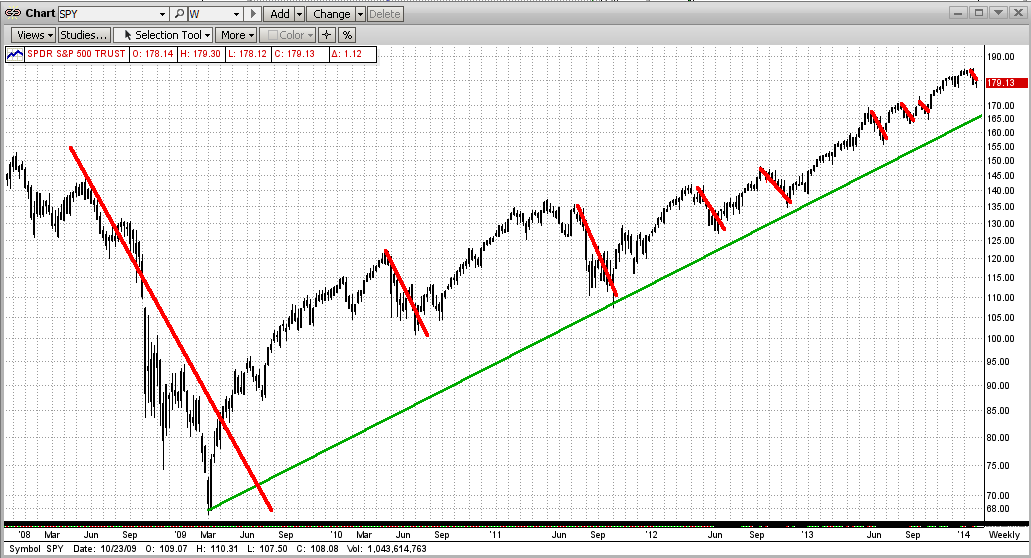
Finally, how did MIPS do in the last 11 years ???
- very well, see the MIPS4 performance below
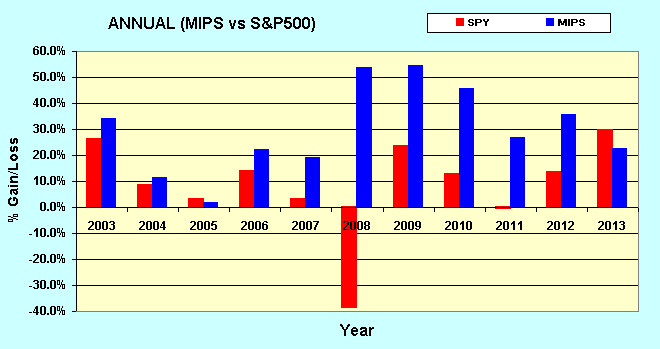
Hope this helps !!!
===================================================================================
| Subject: |
MIPS - Market Crash Coming? |
| Date: |
Sat, 28 Sep 2013 13:42:38 -0500 |
| |
|
|
|
It is not really whether or not a market crash is coming, it's when. How do we know this? Because the big-bad-bear ALWAYS comes.
The very same "evidence" that Buy and Hold pundits (liars) use to prove that buy and hold works, actually proves that it does not !!! Their basic evidence is the "100 Year Dow" graph below. Upon close examination. starting with 1900-1920, you will see 20 good years followed by 20 flat/down years, over-and-over. BTW, being flat or "even" after 20 years is really a tremendous loss, because one would have doubled their money over 20 years with bonds paying only 3.6% !!!
>From the graph below it would seem that, if people lived 100 years or more, the Buy/Hold liars may have a point. But most investors' prime "equity" investment years are from the time that they are say 45 years old (bought house, kids in college, career sound, etc.) until they are 65 years old (approaching retirement, need safe investments, more money in bonds, etc.) So, the prime time span for investors having a large portion of their portfolios in equities is about 20 years.
In the last 110 years, the 20 good/bad periods were:
Good 1900-1920 1940-1960 1980-2000
Bad 1920-1940 1960-1080 2000-????
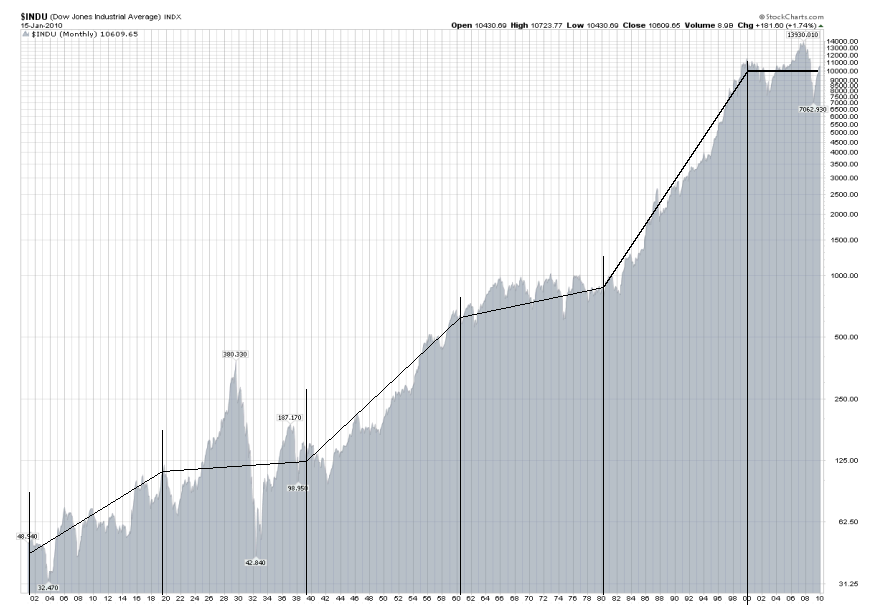
Almost everyone knows that the stock market in 1920-1940 experienced the biggest crash in the last 110 years, and we have personally "lived" through the market up/downs in 2000-2013. But, what about the market in 1960-1980? For that, see the graph below. One could say that the graph speaks for itself.
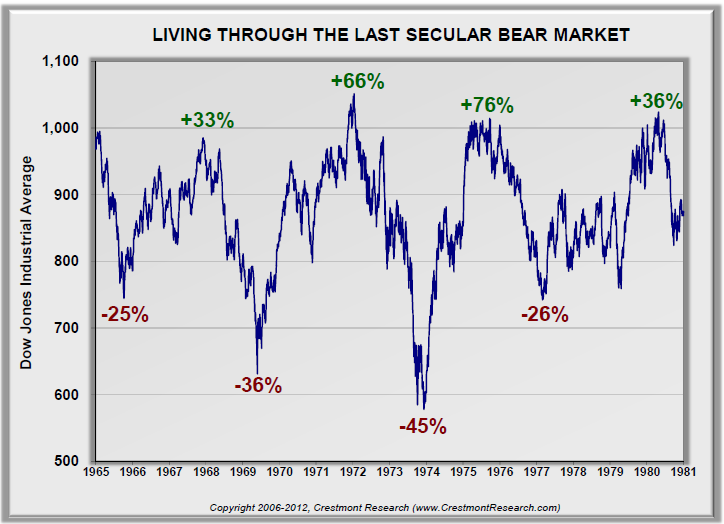
It should be obvious by now that this leaves the time period 2000-???? to dissect. Will we have another big drop? If so, when? And, how fast will the market turn down and will MIPS catch the turn? My experience has shown the market crashes that result from bad fundamentals change slowly (long bubbles like housing, etc.), whereas crashes that come from surprise "events" (like Lehman Bros.) change quickly.
See the graph between 2000-2013 below. We all know (unfortunately) that we have had two big market drops of over 50%. You will probably be relieved to see that, at the top, these markets traded in a range of (+ and -) 5% of their market tops for 8-9 months, before they headed down fast !!!
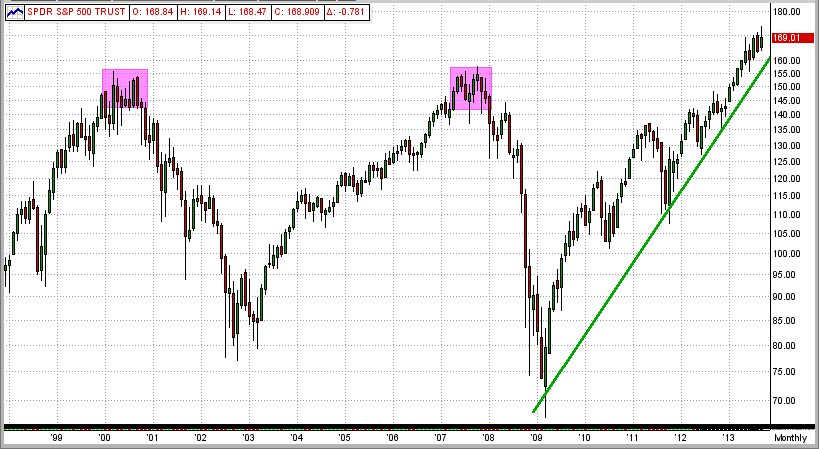
How did MIPS3/MF handle the BIG market crash of 2008?
- Well, it started with a short call on 12/12/07 for a 12% gain, followed by 4 other profitable short trades.
- Total gain of about +40% on the last 3 short trades between Sep'08 - Mar'09) !!!
- See graph below. What, me worry?
Legend: Red Boxes = Short Signals; Green Boxes = Long Signals; Yellow Boxes = Cash
 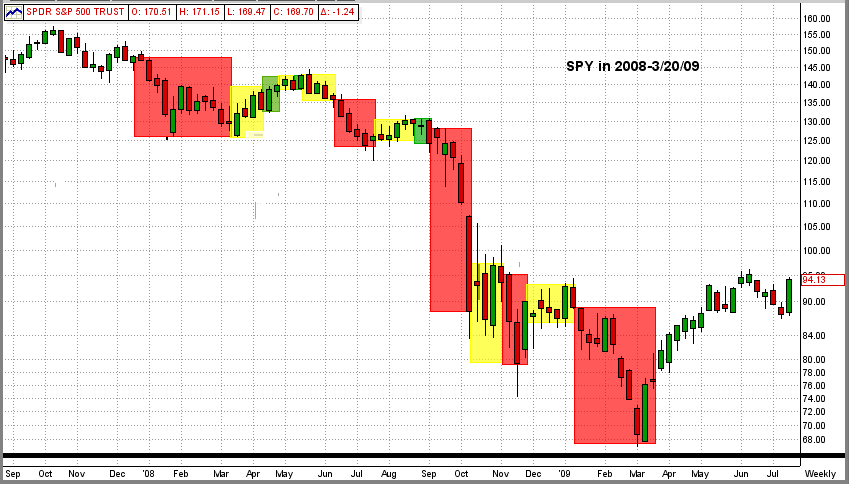
|
Monday, January 20 2014
As most MIPS members already know, we show several possible trading profiles for our MIPS models under the "Services" tab on our main menu at www.mipstiming.com (and more under the "Trading Profiles" button on the Services page).
Also, I have said many times that you can trade any ETF that "correlates" well with the SPY (from Investopedia => http://www.investopedia.com/terms/c/correlation.asp ). Trading SPY/SH is the most conservative trading profile for our long/short MIPS models. However, we will show and will expand upon, more aggressive trading profiles herein.
For aggressive investors, we recommend trading a "mix" of ETFs, like 1/3 each of SPY, IWM, SSO or 1/4 each of SPY, IWM, QQQ, SSO on long signals and their respective inverse ETFs on short signals (SH, RWM, PSQ, SH*, where *SH is the single leverage inverse fund for SPY because we do not like double leverage on shorts).
See, for example, the results below from trading 1/3 each of SPY/SH, IWM/RWM, SSO/SH long/short:
BTW, on short signals, remember that your options are: (a) 1/3 each of SH, IWM, SH as in #1 below, or (b) 50% each of SH and RWM, or (c) 100% RWM, or (d) 100% SH.
I.) MIPS4/MF+ Trading SPY/SH from 2007-2013
CAGR since Jan'07 SPY=+6.1% vs. MIPS=+31.3% Max Drawdown= -10.6%
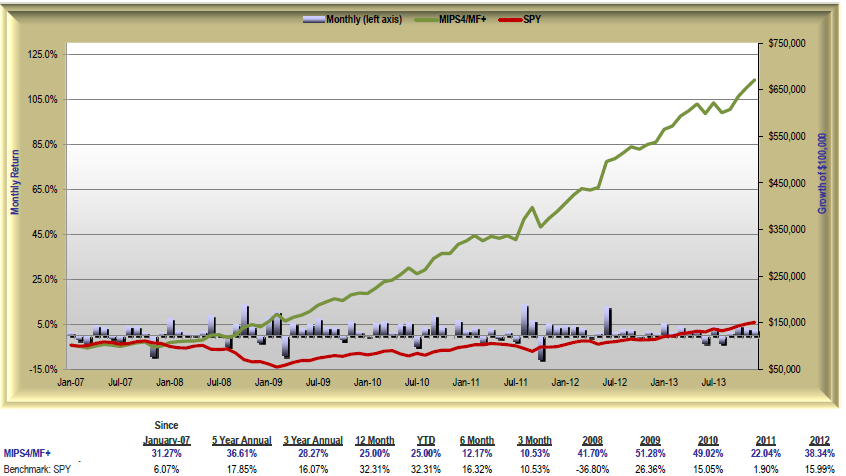
II.) MIPS4/MF+ Trading IWM/RWM from 2007-2013
CAGR since Jan'07 SPY=+6.1% vs. MIPS=+36.9% Max Drawdown= -15.1%
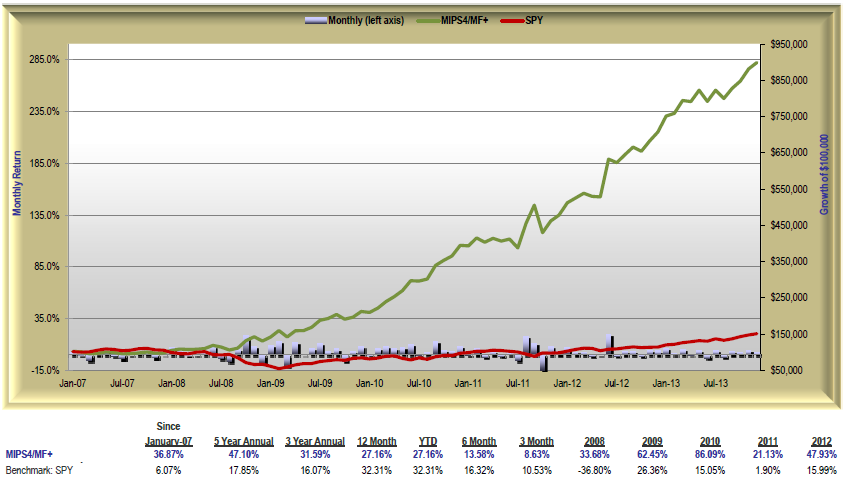
III.) MIPS4/MF+ Trading SSO/SH from 2007-2013
CAGR since Jan'07 SPY=+6.1% vs. MIPS=+52.7%, Max Drawdown= -16.1%
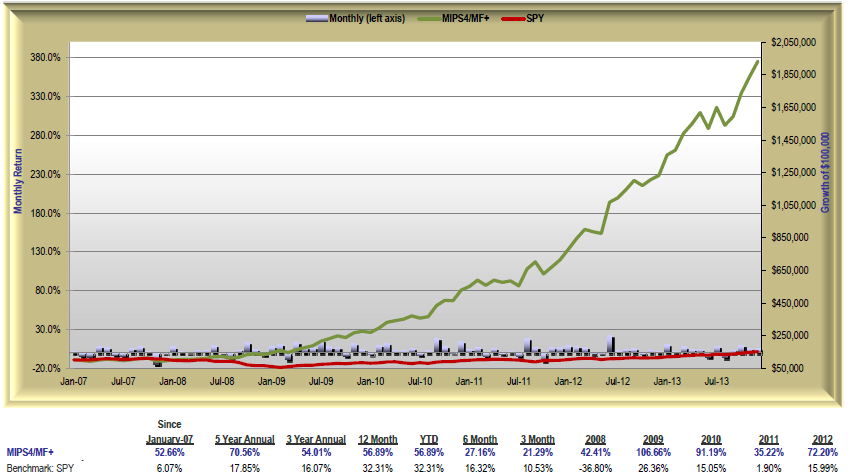
Good "mixing" to all !!!
Monday, January 20 2014
Was the market up or down in the last 4 weeks? Neither. The market (SPY) has been up and down in the last 4 weeks, three times each. The net effect was the SPY bouncing at plus and minus 0.8% around the "mean line" of about $183.36/share. Not very exciting. See the graph below.
Of course, this will not go on forever, and the SPY will once again break out of this most recent sideways trading pattern. My bet is to the upside, but no one can be sure about that. With QE3 alive and well under Yellen, being long is most likely a very good bet.
However, many indicators (both fundamental and technical) are signaling the high probability of a "correction" of at least 5-20% in 2014, but who really knows. What we can be sure of is that one day the market will take a dive that could result in another big "crash". But when? Don't know, and that is why we use MIPS.
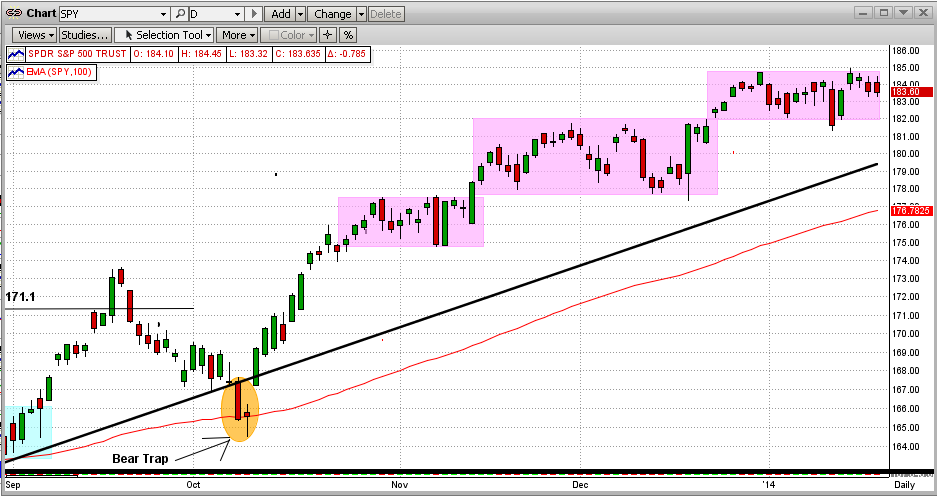
Tuesday, January 07 2014
I would like to examine the graph below from two different perspectives. One is from the MIPS viewpoint and the other is from the perspective of how the stock market behaves at the very end of one year and the beginning of the next. The second perspective has nothing to do with the MIPS models, but it is still very interesting because it does the same thing almost every year.
First, from the MIPS viewpoint, the graph below shows the third flat/sideways trading pattern for the SPY since the end of October 2013. In general, these sideways patterns will break out in the direction that they went in (all of the last three from the upside). The MIPS models called all of these correctly and stayed long. At this point, there is no indication of which way the SPY will break out of this new sideways trading pattern, but the odds are to the upside at this point (but, we all know that this can change in a matter of days).
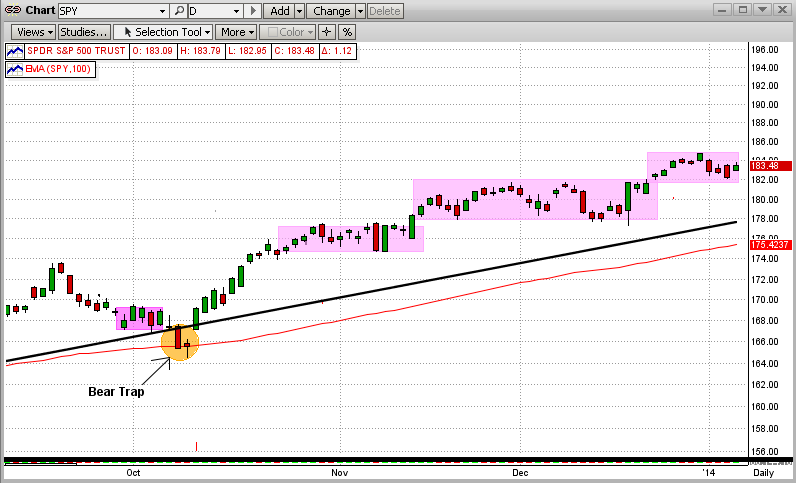
Secondly, from the viewpoint of market behavior, the following phenomenon repeats time and time again.
1) The "Santa Claus Rally" is obviously a rally at the end of December. Many people feel that a major reason for this is that mutual funds buy "winners" in late December to include in their current year-end portfolio to make it appear as though they have owned these winners all year (and hence they show a portfolio of winners). This December, the SPY was up for the last seven trading days.
2) The "January Effect" is the belief (and subsequent behavior) that year-end bonuses are mostly paid in January, which leads to heavier individual buying, thus pushing the market higher. It usually works this way unless some unexpected bad news develops. However, the first few days of every January have a tendency to be down as investors dump their last-year winners to (a) protect their profits and (b) take their gains in the current year instead of in the prior year for tax reasons.
3) Watch for what is called the "January Barometer". This term results from the fact that statistically, the market performance in any given year mimics the market performance in January of that year. For example, if the market is up in January of any given year, there is roughly a 90% chance that the market will be up for that year (and vice versa, of course). This statistic is from the years 1950-2013. The saying for this is "As goes January, so goes the rest of the year".
Blog from 12/29/2013
In our previous blog below from 12/22/13, we showed how the SPY had climbed quickly back to the top of its flat/sideways trading pattern on high volume. From this one could conclude that we should have expected a "breakout" to the upside this past week. As can be seen in the graph immediately below, we did get an upside breakout this past week, but not what we would call a really strong breakout. This is mainly because of its low volume. The odds are for this breakout to pick up steam and head higher, but it could very easily turn out to be a "bull trap" that turns lower in the short term. It is exactly these kinds of situations when we need for MIPS to tell us what to do.
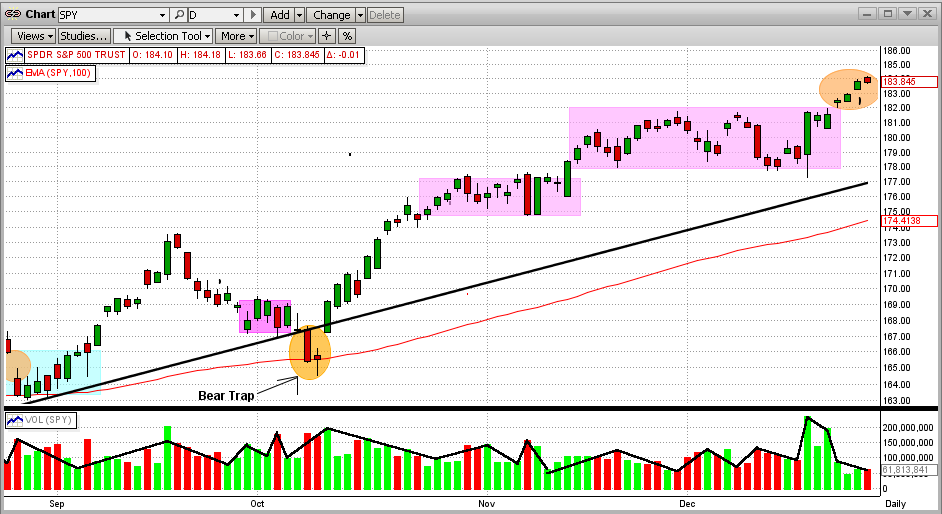
Blog from 12/22/2013
In our previous blog (from 12/16/13), we told our MIPS members to basically ignore the 5-consecutive-day drop in the SPY that occurred in the previous week (see the last graph below). The reasons for this were: (a) the entire drop was just a little over 2% and (b) the market was just completing a drop from the top to the bottom of a relatively flat/sideways 15-day trading pattern.
Then this last week, the SPY basically reversed it movement and simply went back to the top of the trading pattern (see graph immediately below). No breakout. So, is this week's move up any different than last week's move down? In many cases, the answer would be no. But, there are some compelling reasons for believing that the recent move up was indeed more telling than the previous move down, even though there was no breakout. One reason is that the trading pattern is now over 20 days old, and sideways trading patterns usually do not last much longer than that. But the BIG reason to think that this move up is different from the prior moves is that the move up was on volume almost two time higher than the volume for the prior 30 days. Thus, one can conclude that the move up was the result of the big guys buying. That's huge!!!
The real story will most likely unfold within the next week or two, so let's stay long and wait for MIPS to tell us what to do next.
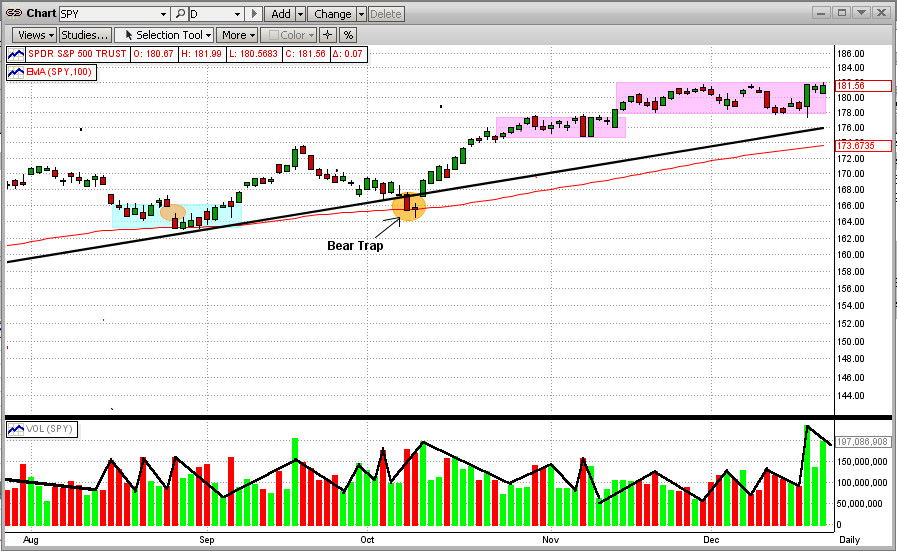
Sunday, December 29 2013
In our previous blog below from 12/22/13, we showed how the SPY had climbed quickly back to the top of its flat/sideways trading pattern on high volume. From this one could conclude that we should have expected a "breakout" to the upside this past week. As can be seen in the graph immediately below, we did get an upside breakout this past week, but not what we would call a really strong breakout. This is mainly because of its low volume. The odds are for this breakout to pick up steam and head higher, but it could very easily turn out to be a "bull trap" that turns lower in the short term. It is exactly these kinds of situations when we need for MIPS to tell us what to do.

Blog from 12/22/2013
In our previous blog below (from 12/16/13), we told our MIPS members to basically ignore the 5-consecutive-day drop in the SPY that occurred in the previous week (see the last graph below). The reasons for this were: (a) the entire drop was just a little over 2% and (b) the market was just completing a drop from the top to the bottom of a relatively flat/sideways 15-day trading pattern.
Then this last week, the SPY basically reversed it movement and simply went back to the top of the trading pattern (see graph immediately below). No breakout. So, is this week's move up any different than last week's move down? In many cases, the answer would be no. But, there are some compelling reasons for believing that the recent move up was indeed more telling than the previous move down, even though there was no breakout. One reason is that the trading pattern is now over 20 days old, and sideways trading patterns usually do not last much longer than that. But the BIG reason to think that this move up is different from the prior moves is that the move up was on volume almost two time higher than the volume for the prior 30 days. Thus, one can conclude that the move up was the result of the big guys buying. That's huge!!!
The real story will most likely unfold within the next week or two, so let's stay long and wait for MIPS to tell us what to do next.

Sunday, December 22 2013
In our previous blog (from 12/16/13), we told our MIPS members to basically ignore the 5-consecutive-day drop in the SPY that occurred in the previous week (see the last graph below). The reasons for this were: (a) the entire drop was just a little over 2% and (b) the market was just completing a drop from the top to the bottom of a relatively flat/sideways 15-day trading pattern.
Then this last week, the SPY basically reversed its movement and simply went back to the top of the trading pattern (see graph immediately below). No breakout. So, is this week's move up any different than last week's move down? In many cases, the answer would be no. But, there are some compelling reasons for believing that the recent move up was indeed more telling than the previous move down, even though there was no breakout. One reason is that the trading pattern is now over 20 days old, and sideways trading patterns usually do not last much longer than that. But the BIG reason to think that this move up is different from the prior moves is that the move up was on volume almost two time higher than the volume for the prior 30 days. Thus, one can conclude that the move up was the result of the big guys buying. That's huge!!!
The real story will most likely unfold within the next week or two, so let's stay long and wait for MIPS to tell us what to do next.

|